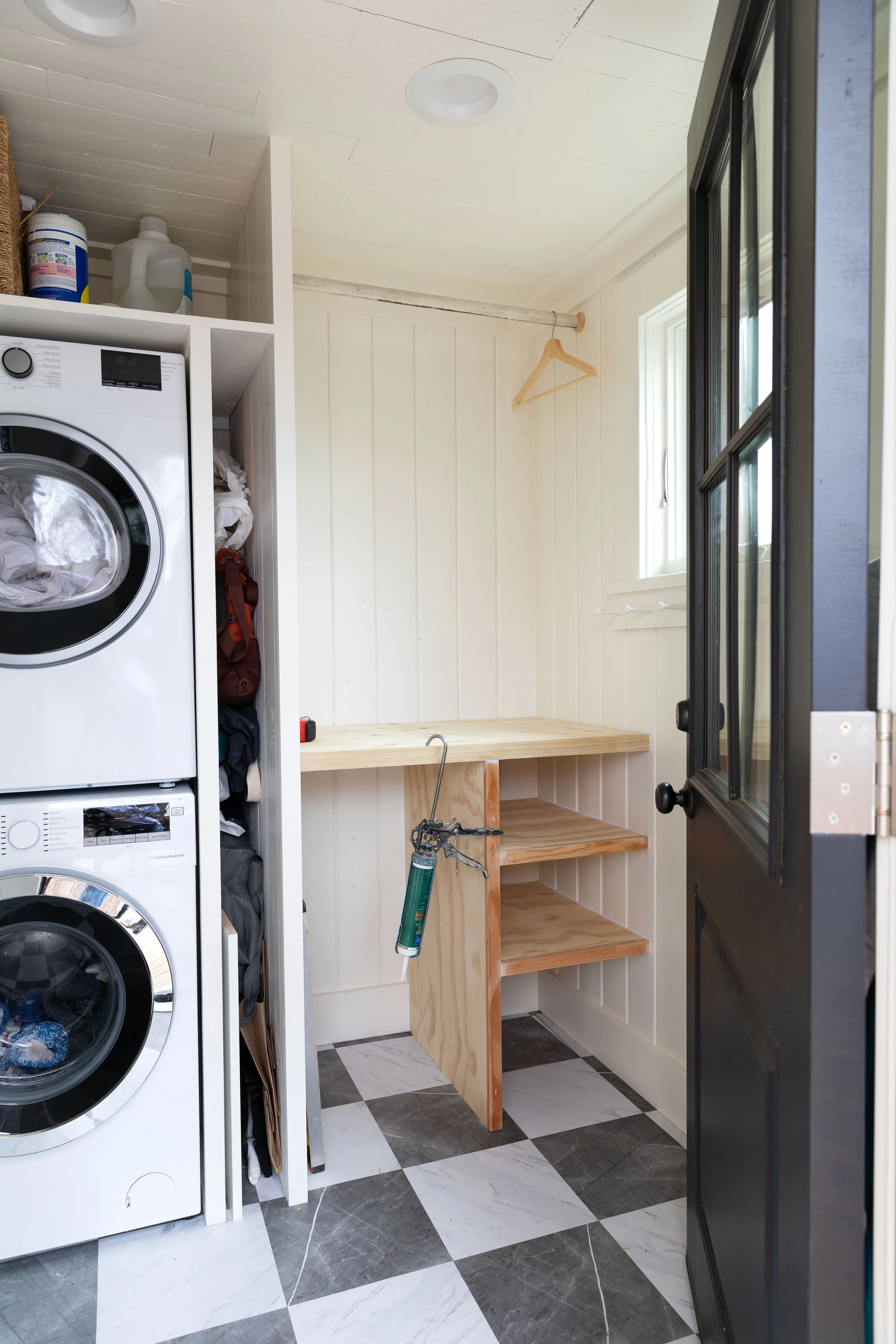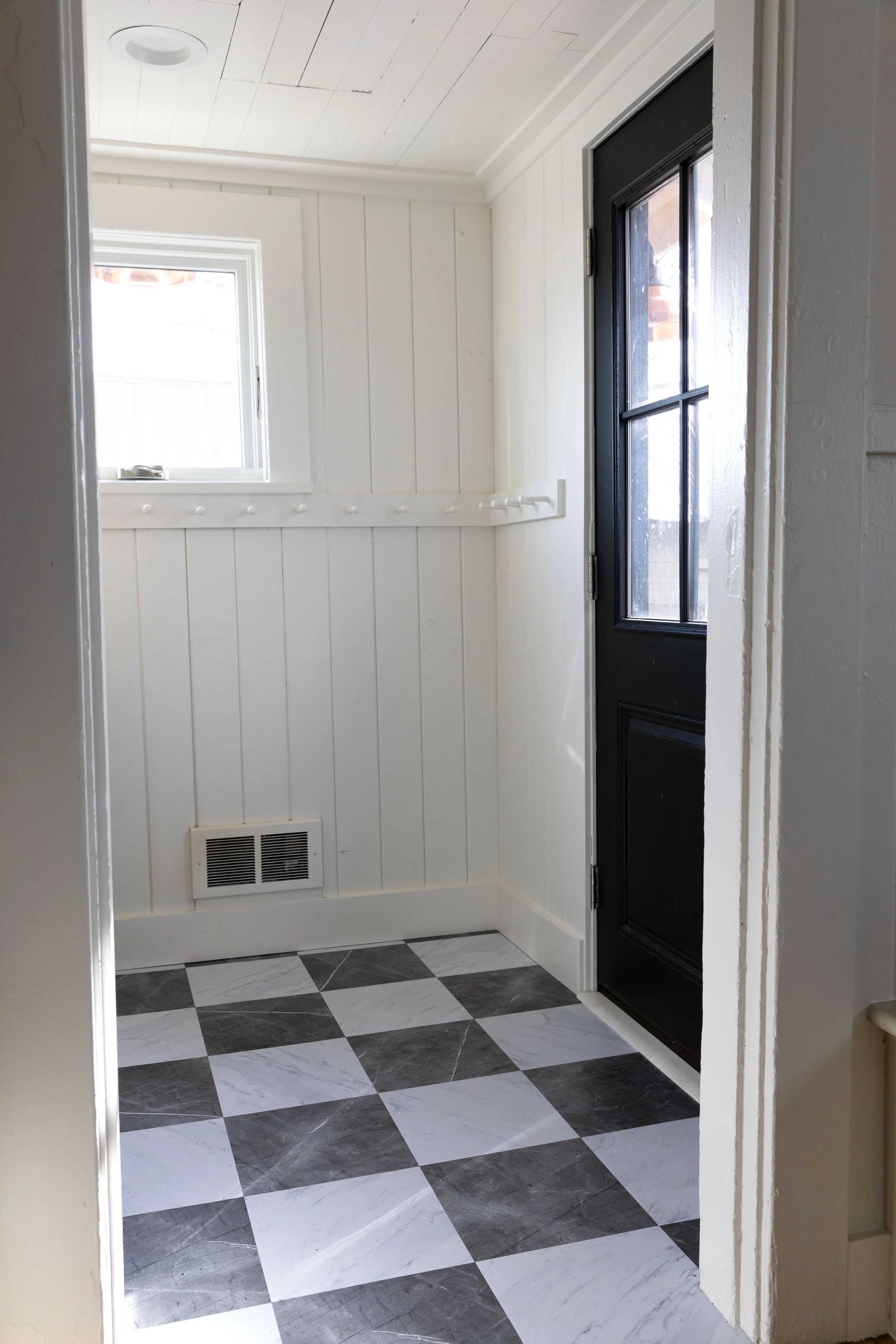How We're Making the Most of a Small Mudroom
THE POPLAR COTTAGE
Let’s talk about the mudroom at the Poplar Cottage! It’s a small space - just 33sf (5’6” x 6’) - and we need the room to handle everything from muddy boots to dirty laundry to overflowing backpacks, ideally without feeling cluttered. A tall order! Today we’re showing you progress on our mudroom and walking you through the layout and storage we’re using to transform a cramped room into a hardworking, charming mudroom.
That’s what the mudroom looks like today. BTW for anyone who doesn’t know, our family of 5 is officially living in the Poplar Cottage while we start in on the Hill House renovation, but eventually the house will be an Airbnb. So we need the space to work for both uses.
Here’s a look at where this room started…
That’s the only photo I could dig up. But trust me that it was just as dark and inefficient as it looked here. Maximizing the functionality of the room for storage and laundry and as an entrance was top priority. Here’s how we’re doing it…
layout
Especially in a small space, fine-turning the layout of a mudroom makes a world of difference. We started designing our space by considering what will go in the mudroom and the flow of traffic. Where do you typically enter and exit? Where’s the drop zone? Can we make sure the room will fit two or more people at the same time? We also consider sight lines to try and avoid messes in view of the doors (I swear this can really affect my stress levels!). Here are some things we considered:
What goes into the mudroom: every family and house will have a different list, but we’re planning to use our mudroom for: in-season outerwear, school backpacks, hats, everyday footwear, sports bags, keys and wallets, laundry, broom and mop.
Identify a "Drop Zone": In the Poplar Cottage, we pinpointed the area where everyone naturally dropped their belongings. This became the core of our mudroom organization.
Maximize Vertical Space: In a small mudroom, every inch counts so we decided to install a small stackable laundry unit to minimize its footprint.
Sight-lines: We tried to think through organization and avoid clutter in areas visible from the doorways as best as possible so that this mama can feel a sense of calm in the house, no matter the state of the entry.
laundry by Beko | door | floors
Essential Mudroom Storage
Finding good mudroom storage solutions can work wonders for small spaces (and big spaces too!). On the large size, we like to include lockers and built-ins to maximize mudroom storage and keep the clutter organized. Here’s where we start:
Lockers: We’re big fans of lockers in a mudroom and used them in the Farmhouse and our kids loved them (we’ll likely be adding some to the Hill House when we get to that renovation)
Built-in shelves: shelves are the perfect spot to stack baskets and bins with mudroom essentials. Garrett built some in at the Poplar Cottage and we plan to top the shelf with a leftover piece of quartz.
Broom closet: At Poplar we carved out space for a tall pull-out broom closet to allow space for a broom and mop. We’re still working out how we’ll built it, but however it comes to fruition it should be incredibly handy.
Baskets and Bins
Baskets and bins are my favorite weapon in the battle against clutter ;) We tend to use woven basket because they’re pretty and hide the mess inside, but other baskets and bins work well for different storage issues. Things we like to store in baskets:
Woven Baskets: hats, shoes, winter wear, pet toys, and anything that tends to accumulate.
Wire Baskets: Perfect for storing items that need to breathe, like sports equipment or anything wet.
Labeled Bins: Clear bins with labels make it easy to find what you need quickly and are especially helpful for kids' belongings.
Clear Bins or open shelves: These create visual interest and provide a spot for decorative items or frequently used items like sunglasses.
Laundry cart: for mudrooms that double as laundry, we like to use roll-out laundry carts. This one will fit perfectly in the opening below the shelf.
Hanging Storage and Hooks
Hooks and hanging bars can drastically increase a mudroom's functionality. For the Poplar Cottage we lined the walls with shaker pegs and added a hanging rod above the countertop (for coats and for hanging up wet laundry).
Shaker pegs: shaker pegs are nostalgic and incredibly functional. We’ve added them to many house renovations over the years and they felt like the right option at the Poplar Cottage.
Heavy-Duty Hooks: We also love sturdy, metal hooks that can hold the weight of winter coats and heavy bags.
Over-the-Door Organizers: For small spaces, over-the-door organizers can provide extra storage for shoes, hats, or cleaning supplies.
Hanging rod: consider a hanging rod if room allows to store coats and also hang up wet clothes.
Shoe storage
Shoes are the major culprit when it comes to mudroom clutter, at least in our home. Here are a few solutions to keep them organized-ish:
Shoe Benches with Storage: I love a bench with built-in shoe storage in a mudroom! We added one in the adjacent kitchen to provide a spot to take on and off shoes and provide hidden storage.
Slim Shoe Cabinets: If you have wall space, thin shoe cabinets (like this one) that fit closely against the wall are a beautiful solution.
Wire Shoe Racks: Simple and affordable, wire shoe racks keep shoes off the floor and organized. Ideally these are tucked away out of sight.
Boot Trays: For those of us who live in wet and/or snowy weather, boot trays are a great way to protect your floors from mud and moisture.
Baskets: when space allows, we give each kid a woven basket to tuck away shoes they’re not wearing.
Flooring
Another consideration in mudroom design is flooring. These spaces are high-traffic, so durable, easy-to-clean flooring is essential. Here are a few materials we consider:
Tile: Tile is a classic choice for mudrooms. It's easy to clean, water-resistant, and comes in a variety of styles.
Brick or Stone: For a rustic look, consider brick or stone flooring. These materials are incredibly durable and add character to the space.
Vinyl Tile: Vinyl is a budget-friendly option that mimics the look of natural stone or wood. It's also water-resistant and easy to maintain and our pick for the Poplar Cottage due to floor height restrictions.
Sealed Concrete: A sealed concrete floor offers a modern, industrial look and is incredibly durable.
Lighting and Finishing Touches:
A few other things to consider in a mudroom:
Adequate Lighting: Mudrooms are one of those spaces where the more light the better. If you can swing it consider multiple sources like overhead lighting, natural lighting (aka windows), sconces, and lamps. We drastically brightened this space with a new door with glazing in it and kept to can lighting because of the low ceiling height.
A Durable Rug: There’s something so cozy and welcoming about a rug in a mudroom. I’m not sure we’ll add one in here due to the small space, but we loved having one at the Farmhouse. Bonus: it protects your floor!
A Mirror: If you’re like me, a last-minute mirror check is a must to make sure there’s no food in my teeth or my hair isn’t a disaster ;)
Family Org: In my dream mudroom, a family organization whiteboard and pin board would grace a wall in order to hang schedules, invitations, reminders, kids art, etc.
Of course organizing a mudroom and keeping it organized are two different things (especially with our sweet, wonderful, messy kids ;). My main plan to keep this small space tidy is to edit, edit edit! The less things that need to go in this space, the less mess there will be. Storing out of season gear elsewhere like in the garage (or a basement if you have one), and duplicate sweatshirts in their bedrooms, should help contain the stuff! At least that’s my hope :)
Can’t wait to see this space finished!





















